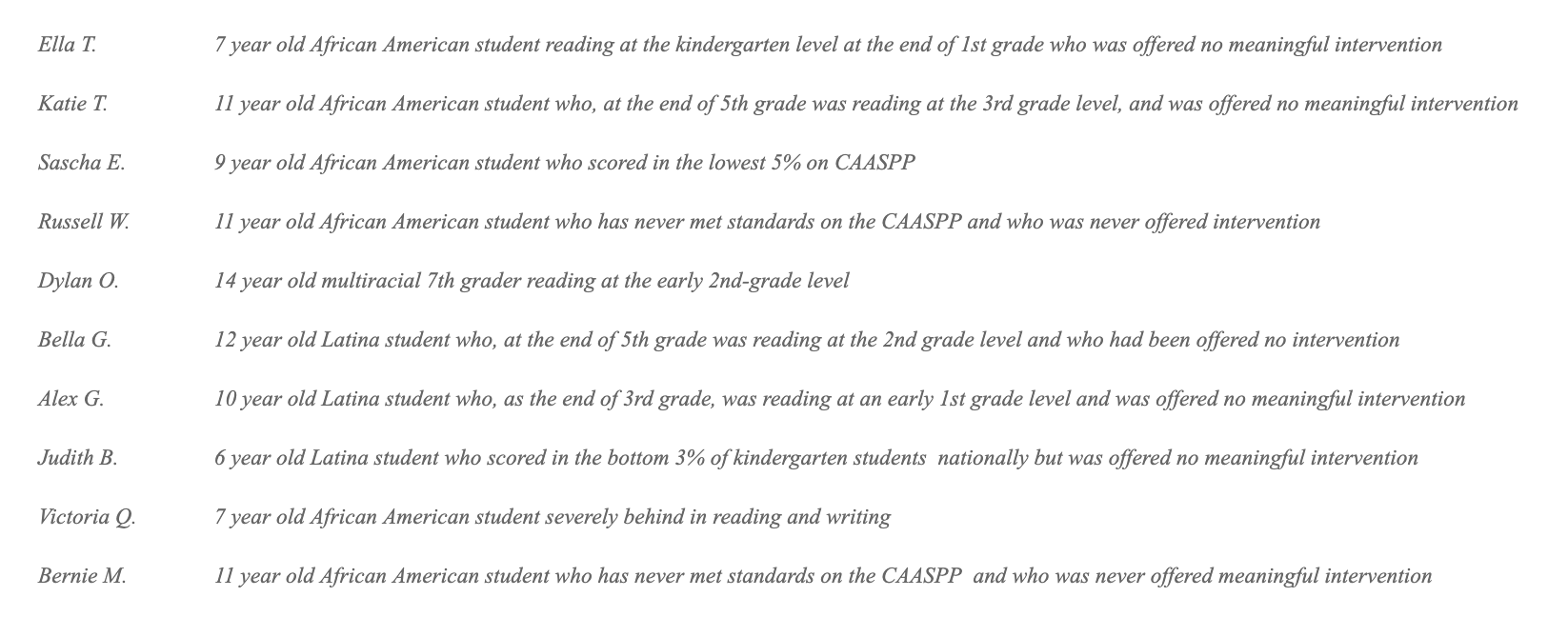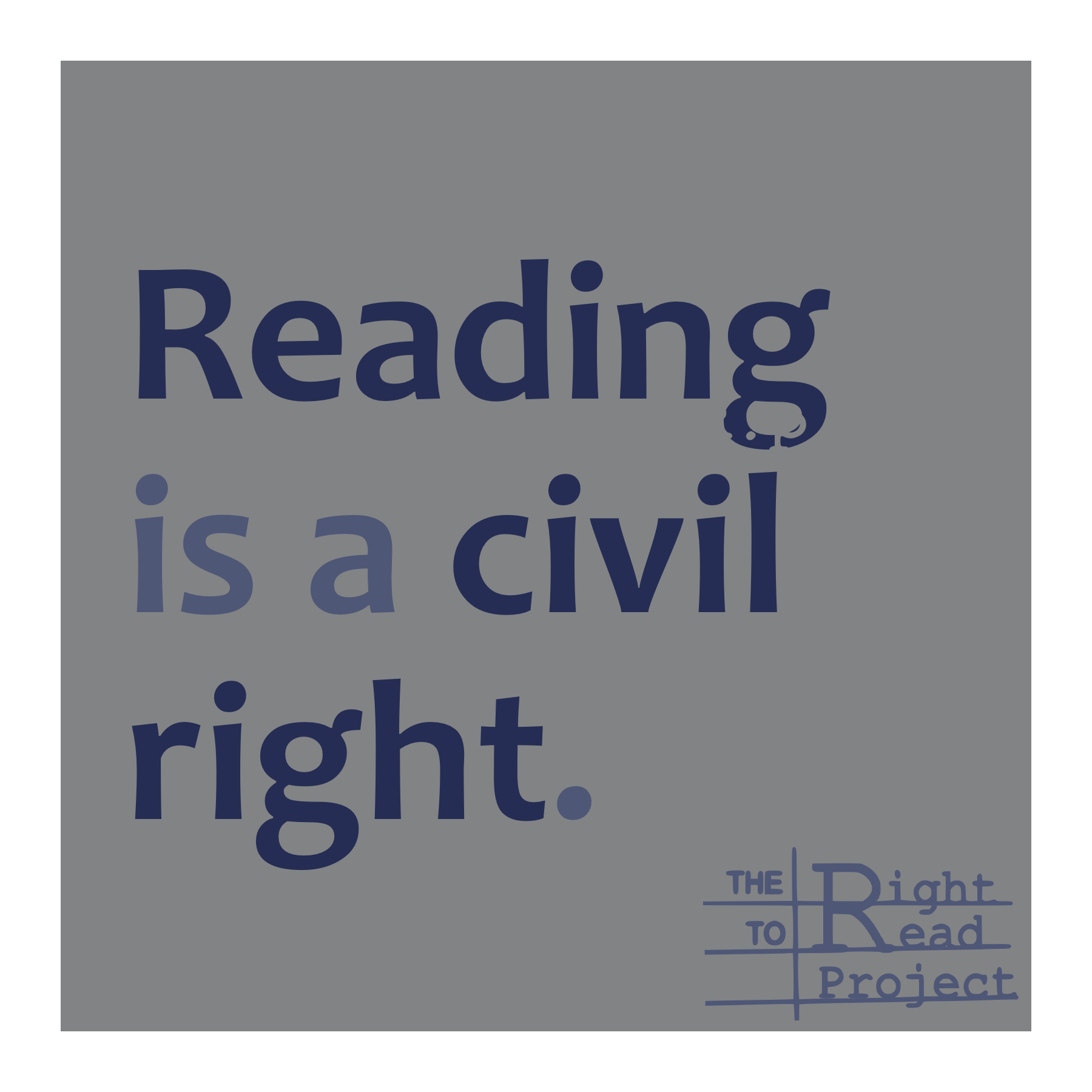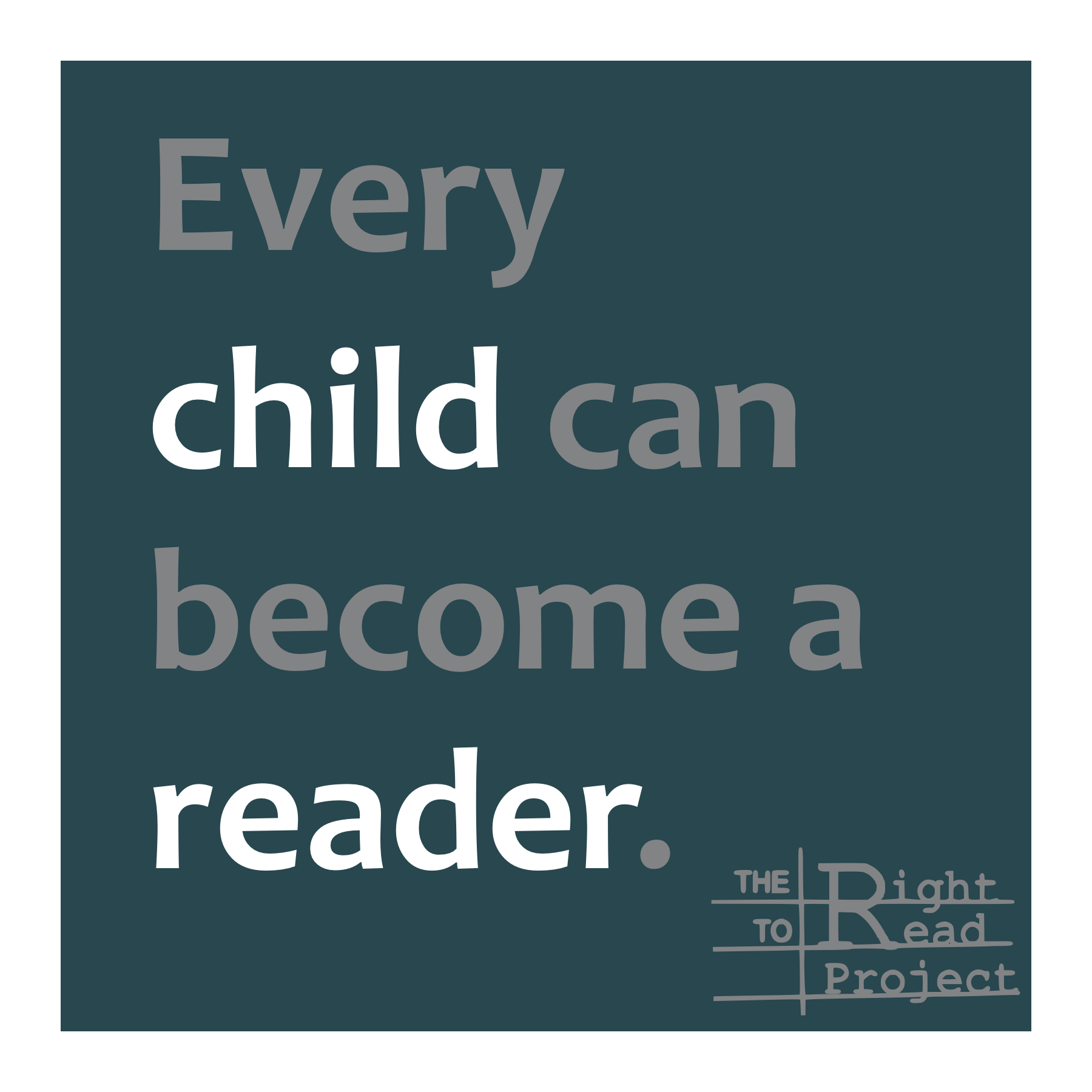Why didn’t he learn to read when he was in elementary school?
We often focus on the child, his behavior, family, or teachers. He has a learning disability. He never sits still. That family just doesn’t prioritize school. He had teachers who just didn’t care. We tend to attribute reading difficulty to a child’s individual problems or to circumstances beyond our control. And we rarely see that many of our schools are simply not set up to teach reading well.
Here in California, ten students who had not learned to read proficiently held state education officials accountable by filing a lawsuit, Ella T. vs. the State of California. If you’ve worked in an elementary school like mine, the writing samples included in the lawsuit may look familiar.
And if you skim through the list of plaintiffs, you may think, “So many of our students could have been part of this lawsuit. These profiles sound so familiar.”

Ella T. vs. the State of California ended with a $53 million dollar settlement– money that didn’t go to the plaintiffs but rather to seventy-five of the lowest performing schools in the state– an acknowledgement that the ten students who sued represent hundreds of thousands who have been failed by a broken educational system.
My new school (Nystrom Elementary in Richmond, California) is one of the sites included in the grant and I lead the professional development for other literacy coaches. We decided collectively that we would each dedicate our coaching this year to one of the students who sued–and then do our best to ensure that our own students would have a better experience in school.
Clark G.
For weeks after that first meeting with the coaches, I thought about a student I met within a few weeks of my arrival at Nystrom. Clark G. is a fifth-grader who has attended the school since kindergarten. He’s well-behaved, insightful, and kind. He’s got two parents who care deeply about his education and he’s well-liked by his classmates and teachers.
Clark is a good, smart kid. And at the start of this school year, he scored in the <1 percentile on the DIBELS reading assessment.
He scored in the <1 percentile on the STAR reading assessment as well. His teacher administered a diagnostic assessment and discovered that Clark was struggling to read words that required kindergarten phonics, words like van, rug, and job.
Like the students in the lawsuit, Clark has never received any reading intervention. He’s scored at or below the third percentile on the STAR reading assessment for years, but those red flags were ignored; his reading difficulties were masked by his strong verbal skills and hard work, and there were (are) hundreds of other students in the school who were failing more obviously.
Scrolling through the reports, I saw red data all through fourth grade. And third. (The scores are listed in reverse chronological order—most recent on top.)
Digging Deeper
But as I dug deeper and deeper into his file, I noticed a blip of hope in Clark’s second grade scores.
In October of second grade, Clark had made gains only to crash down again by February. I wondered if his second grade teacher had noticed the rise and fall of his score, so I dug into my school’s files. I learned that Clark had been one of his teacher’s “focal students,” a child to whom she’d chosen to give a little extra attention.
I wasn’t surprised to read that in second grade he was “unfocused during [Drop Everything And Read] time” because years later, he’s still struggling with basic phonics. Nor was I surprised to learn that it took him more time to complete assignments, given how difficult the basics of writing are for him. But I was surprised to discover that he appeared to like reading.
His teacher wanted to help him, but she lacked the tools and training necessary to explicitly teach him foundational skills. With only a “light-touch” phonics program, her strategies were limited to loose mini-lessons, practice with leveled books, and reading aloud. Clark wanted to learn and she wanted to teach him, but without a systematic plan for instruction, neither of them stood much of a chance.
The Power of Effective Instruction
After scrolling through so much red data for Clark, I was caught off guard by his first grade scores.
In the beginning of first grade, Clark had nearly the same yellow score as he’d had in early second grade (11th and 12th percentiles), but his learning trajectory was different in first grade. How had this surge happened?!
My principal answered my questions by sending me videos of Clark’s first-grade classroom. In the recordings I saw literacy centers; students quizzing each other on spelling-sound patterns, another group practicing high-frequency words, and the teacher providing one-on-one intervention in letter names informed by progress-monitoring data she held on a clipboard.
On the whiteboard I could see the spelling-sound cards TH and SH posted and dictation from the day’s lesson, “I wish that the shop had not shut.” On the other sound-spelling cards posted at the front of the room were phonics patterns the teacher had already taught and some, covered by Post-Its, that she would systematically unveil during her lessons over the course of the year.
I saw first-grade Clark sitting in a circle with three classmates, rereading a decodable book. He was focused on his reading, pointing carefully to the words, never looking up at the camera.
In the video, in the class’s data, and in Clark’s scores, I could see evidence of her systematic, explicit instruction with cumulative daily review.
And in Clark’s kindergarten data I could see exactly why a structured approach to reading instruction mattered so much. On the first administration of the STAR assessment, he scored “On Watch” and, on the second, “Strategic Intervention.” Early literacy data is the closest thing we have to a crystal ball in education and the numbers on a universal screener are more effective in identifying reading difficulties than any teachers’ intuition.
From the time he was five years old, Clark’s data screamed out to the adults to keep a close eye on him. He was the barometer of effective reading instruction, but when his scores slipped no one on site knew how to intervene. When we scan down Clark’s scores over the years, we can pinpoint when things went wrong for him.
Clark teetered on the edge in kindergarten, was solidly at benchmark in first grade, and then plummeted in second, staying down from that point on.
A Nation of Clarks and Ellas
Too often, data like these are explained away with statements such as, “He had a bad teacher and he never recovered.” But the problem isn’t a single teacher nor is it a string of teachers. Clark is one of hundreds of struggling readers at my school, one of thousands in the schools that are benefiting from the Ella T. settlement, one of millions struggling across our nation. Children are failing to read en masse not because of individual teachers, but because the system in which we teach is broken.
To help students like Clark and Ella, students who depend on high-quality, explicit, systematic instruction in order to learn how to read, we need to institute supports that ensure every teacher is successful:
Schools need:
- A scope and sequence for foundational skills that is spans across the grades
- Progress-monitoring data to ensure that every student masters the skills covered by the curriculum’s scope and sequence
- Lesson plans containing explicit, direct instruction so that teachers have the tools needed to teach effectively
- Professional development to ensure that teachers know how to implement the lesson plans provided and we understand why each component of instruction is important
- On-site coaching to show us how to tailor those lesson plans to the students in our classrooms
- Diagnostic assessments to help us differentiate foundational skills instruction within and/or across classrooms
- Valid, predictive, reliable screening data to determine which students are at risk of reading difficulty and to evaluate the efficacy of instruction at the classroom, grade, and school levels
- Training for leaders on how to ensure that effective reading instruction is the top priority for the district and every elementary school
Ella T. and nine other students filed a lawsuit because they were not properly taught to read, but every teacher across the nation has had students who could have signed on. In their complaint, the students said:
Public schools in America were conceived as the engine of democracy, the great equalizer that affords all children the opportunity to define their destinies, lift themselves up, and better their circumstances. Student Plaintiffs are full of potential and want to learn. They hold high aspirations; they seek to become, for example, doctors, lawyers, hairstylists, racecar drivers, and paleontologists, among other professions. But the State’s system of education is failing them. An education that does not provide access to literacy cannot be called an education at all.
We owe it to our students to fight for change because, as Ella T. wrote:

I n e e d h e l p









This is a fantastic article.
Thank you for providing a case study and data.
I am shouting as loudly as I can that our schools must follow reading research.
Your site is excellent.